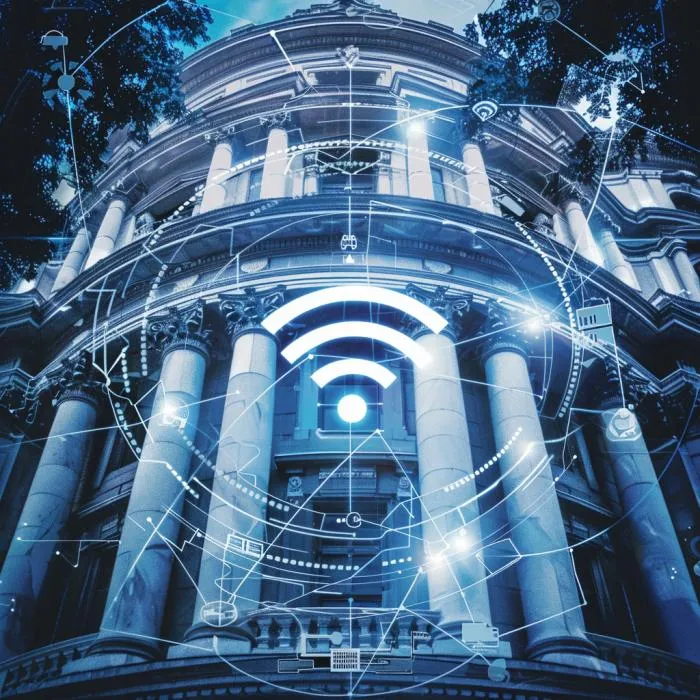
Wireless Communication Challenges in Historical Buildings and How to Overcome Them
Historical buildings present unique challenges when it comes to implementing modern wireless communication systems. These structures, often constructed long before the advent of wireless technology, can significantly hinder signal propagation due to their design and materials. At DAS University, we recognize the importance of preserving the integrity of historical buildings while ensuring they meet contemporary communication needs. This blog post explores the wireless communication challenges faced in historical buildings and strategies to overcome them.
Challenges in Historical Buildings
Thick Walls and Dense Materials
Signal Obstruction: Many historical buildings are constructed with thick walls made of dense materials such as stone, brick, and concrete, which can significantly obstruct wireless signals.
Limited Penetration: These materials limit signal penetration, resulting in weak or non-existent coverage in certain areas.
Complex Layouts and Architecture
Intricate Designs: Historical buildings often feature complex architectural designs, including narrow corridors, high ceilings, and multiple floors, creating a challenging environment for signal distribution.
Dead Zones: The combination of thick walls and intricate layouts can create numerous dead zones where wireless signals cannot reach.
Preservation Requirements
Aesthetic and Structural Integrity: Preservation guidelines often restrict modifications to historical buildings, limiting the ability to install modern communication infrastructure.
Regulatory Compliance: Ensuring compliance with preservation regulations while implementing wireless solutions can be a delicate balance.
Electrical Interference
Outdated Wiring: Historical buildings may have outdated electrical wiring and infrastructure, leading to interference with modern wireless systems.
Limited Power Availability: The availability of power sources for wireless equipment can be restricted due to the building’s design and preservation constraints.
Strategies to Overcome Wireless Communication Challenges
Conduct a Thorough Site Survey
Assessment: Perform a detailed site survey to map out the building’s layout, identify signal obstruction points, and determine areas with weak or no coverage.
Customized Plan: Use the survey data to create a customized wireless communication plan that addresses the unique challenges of the historical building.
Utilize Distributed Antenna Systems (DAS)
Strategic Placement: DAS involves strategically placing multiple antennas throughout the building to ensure comprehensive coverage and eliminate dead zones.
Minimal Intrusion: DAS can be designed to minimize intrusion on the building’s aesthetics, with antennas and cabling concealed or integrated into existing structures.
Leverage Small Cells
Targeted Coverage: Small cells can be used to provide targeted coverage in specific areas with weak signals. These compact, low-power nodes are ideal for supplementing coverage in challenging environments.
Discreet Installation: Small cells can be discreetly installed in less visible locations to preserve the building’s historical appearance.
Employ Signal Boosters and Repeaters
Amplified Signals: Signal boosters and repeaters can amplify existing wireless signals, extending coverage to hard-to-reach areas within the building.
Non-Invasive Solutions: These devices can be installed with minimal disruption to the building’s structure and appearance.
Implement Fiber Optic Backbones
High Capacity: Fiber optic cables provide high-capacity, high-speed connectivity, serving as a backbone for wireless systems like DAS and small cells.
Flexible Routing: Fiber optic cables can be routed through existing conduits and spaces, reducing the need for intrusive installation.
Collaborate with Preservation Authorities
Early Engagement: Engage with preservation authorities early in the planning process to understand the specific regulations and guidelines that must be followed.
Collaborative Planning: Work collaboratively with these authorities to develop solutions that meet both preservation and communication needs, ensuring regulatory compliance.
Use Low-Profile and Aesthetic Equipment
Design Considerations: Choose wireless equipment designed to blend with the building’s aesthetics, such as low-profile antennas and camouflaged access points.
Hidden Installations: Wherever possible, install equipment in hidden or less visible areas to maintain the building’s historical appearance.
Regular Maintenance and Monitoring
Proactive Management: Implement a proactive maintenance schedule to ensure that the wireless communication systems remain operational and effective.
Continuous Monitoring: Use real-time monitoring tools to track system performance and quickly address any issues that arise.
Case Study: Successful Wireless Implementation in a Historical Building
Consider a historical museum that faced significant challenges in implementing wireless communication due to its thick stone walls and intricate architectural design. By conducting a thorough site survey and collaborating with preservation authorities, the museum was able to implement a DAS solution with strategically placed antennas and fiber optic backbones. The result was comprehensive wireless coverage throughout the museum, allowing visitors and staff to stay connected without compromising the building’s historical integrity. Discreet installation techniques ensured that the wireless equipment was virtually invisible, preserving the museum’s aesthetic appeal.
Conclusion
Implementing wireless communication systems in historical buildings presents unique challenges, but with the right strategies, these challenges can be effectively overcome. By leveraging technologies such as DAS, small cells, and signal boosters, and by collaborating with preservation authorities, it is possible to ensure reliable wireless coverage while preserving the building’s historical integrity. At DAS University, we are dedicated to educating professionals on these advanced solutions, preparing them to tackle the complexities of modernizing historical buildings with wireless communication. Join us to learn more about enhancing connectivity in historical structures and become a leader in this specialized field.



